Gold & Precious Metals
As we see gold and silver prices plunge lower (again) today; it becomes an especially good idea to step back, and look at the Big Picture of these markets. Why? Because nothing happened today.
What is the official propaganda today from the Corporate Media on why precious metals prices have fallen?
…Federal Reserve Chairman Ben S. Bernanke said stimulus may be reduced later this year as the economy recovers.
The problem here? B.S. Bernanke (aka “The Boy Who Cried Exit Strategy”) has been saying this every day for 4 ½ years. There was literally not one word that was new. It could have all been copied-and-pasted from one of his 2009 scripts. Simply calling this “news” is a perversion in and of itself. So nothing happened today in bullion markets.
With today’s price-action having no connection with the real world, and with any Bernanke “prediction” of an Exit Strategy having no connection with sanity; it behooves us to look at the actual supply/demand dynamics for bullion markets – something never attempted by the Corporate Media itself.
…..read more of this Peter Grandich recommended article HERE

In April the gold price buckled and fell $330, $200 of which took only two days. It was a well-engineered bear raid, initiated by over 400 tonnes of ‘short’ positions on the COMEX futures and options market. But the futures and options market is not likely to cause the price of gold to fall as only 5% of that market involves the physical delivery of gold and then only after the counterparty has been put on notice that physical delivery of gold is required.
But over the period of the bear raid, 200 tonnes of physical gold was sold and delivered from the COMEX warehouse. The two main banks involved, JP Morgan Chase and Merrill Lynch, used up at least 200 tonnes of their own gold selling it to force the price down. But the main incentive to sell came from the persistent sales of gold from the SPDR gold ETF, which has seen around 500 tonnes of gold sold from the fund over the last three to four months. So the big holders of gold in the U.S. sold just under 1,000 tonnes of gold in the last three to four months, with the bulk being sold in mid-April. It is therefore quite a surprise that the gold price only fell the $330 that it did.
The focus of this piece is not to look at the potential for a ‘short squeeze’ (which is huge) but to look at the ability of the U.S. institutions involved to not only repeat the exercise, but to influence the gold price in the future. More particularly can the country push the gold price down much further or has it used up all its powder in the last bear raid?
The SPDR Gold ETF & the Gold Trust
These two gold ETFs are the main holders of gold in the U.S. The Gold Trust, at its peak, held 200 tonnes of gold. The SPDR gold ETF held over 1,500 tonnes. Today the Gold Trust is down to 186.33 tonnes and the SPDR gold ETF is down at 1003 tonnes. The unanswerable question is how much more of that 1,000 tonnes is being held with short-term to medium-term profits in mind and how much is being held as a core holding, being held for the long term (i.e. will not be sold no matter what)? If the entire amount is going to be held long-term then no more sales will come from this fund. If another 500 tonnes is a profit oriented holding then this could be sold in the future. The same thinking applies to the Gold Trust. We know that COMEX will consider 200 tonnes held in its warehouses on the low side already and the banks and hedge funds would not be happy to run their stocks down further.
The object of the exercise is to gauge whether the U.S. could launch another bear raid on the gold price and push the price down much further.
Is the Price of Gold Relevant to Price Vulnerability?
Price is also a major consideration because that will dictate the response demand will give. After the gold price crashed in April, physical demand from all over the world came in frantically to pick up gold. We estimate that nearly the entire amount sold went to Asia or central banks and has left to market into very long-term holder’s hands. For that gold to return to the U.S.A. would require a price that rose very quickly and looked ‘toppy’, for Asian sellers to come to the market as sellers. That price would have to be several hundred dollars over the current price level.
Support for the gold price is further helped by the drop in payable reserves the mines now have. With cost in the gold mining industry per ounce being so high, the volume of profitable reserves drops sharply as the mine has to move to grades that are more profitable. Allowing for a return on capital, the mines currently need between $1,000 and $1,500 to make any profits unless they move to higher grade –so shortening the life of the mine.
Scrap sellers who were comfortable selling gold over $1,650 pull off the market when the price tumbles like this. After all if it rebounds, after they have sold, they are most unhappy, so they wait until the price recovers. So a large chunk of ‘scrap sales’ leaves the markets.
Demand Would Rush in at Lower Prices
Combine these supporting factors and it becomes clear that if the gold price does fall much lower, buyers will rush into the market as they did in May. A ‘bear raider’ could not afford to take the risk of selling physical gold, only to see the gold price jump thereafter. He would then pay dearly to close his short positions. It would be too risky.
So in short, another bear raid is unlikely at these levels. More importantly with the available stock of gold remaining in the U.S. at such low levels, another bear raid would use these up in large part. If that happened the ability of the U.S. gold markets to influence the gold price would be lost completely. The dominant influence over the gold price would have moved to Asia.
Shift of Power over Gold Moves East
What this would mean to the gold price would be that the power of U.S. speculation over the gold price would have been used up as the gold needed for this purpose would have left the States. It would render reports that tell us “the gold price fell because U.S. housing starts had jumped last month” incorrect, because U.S. investors would not have the ability to speculate in the volumes needed to move the gold price.
With the global cash flow, estimated by Wolfensohn, ex-head of the World Bank, changing from 80% to the developed world and 20% to the rest of the world, to 65% to the rest of the world and 35% to the developed world, the Asian influence over the gold price would dominate, relegating the present influences from the developed world, to history.
Is the U.S. Selling Gold from Reserves?
Competent analysts are debating whether central banks are supplying the market to keep the gold price down at the moment. The first question we ask is, “What would this achieve except to delay a collapse of the key currency markets?” With a multi-currency system approaching on the horizon a collapse of the system would have to be an immediate prospect to warrant such sales. This is because when that multi-currency system does arrive, gold reserves will play a pivotal role in the monetary system. So central banks would lose a key resource in maintaining stability in currency markets if they used gold now. Bearing in mind that European central banks individually are locked into a Central Bank Gold Agreement, which does allow sales but has not seen any –in the spirit of the agreement—since 2009.
So we would be surprised to see such sales at this time.
Consequences
What we have looked at in this article is:
1. Do the U.S. markets have the gold available and willing, to be used to suppress the gold price much longer? We think that this amount is dropping daily and will run out.
2. The gold used for that purpose to date has left the U.S. and is now in Asia.
3. A fall from current price levels would attract tremendous demand, so further price suppression would need large volumes of gold to effectively keep prices down.
4. Current supplies of gold are falling precisely because gold prices are so low.
5. With Asia gradually becoming dominant over the gold price, with the view that it should be acquired for the long-term and continuously, the U.S. is losing its influence over the gold bullion markets.
Will the new influences show themselves quickly and dramatically? We think now. What we will see are a narrowing of speculative price moves with a tendency to react less and less to developed world micro events. We will continue to watch the sales from the SPDR gold ETF as a prime indicator of the current U.S. influence and its weight of influence on the global gold market.
Hold your gold in such a way that governments and banks can’t seize it!
Enquire @ admin@StockbridgeMgMt.com
Get it First. Subscribe @
Legal Notice / Disclaimer
This document is not and should not be construed as an offer to sell or the solicitation of an offer to purchase or subscribe for any investment. Gold Forecaster – Global Watch / Julian D. W. Phillips / Peter Spina, have based this document on information obtained from sources it believes to be reliable but which it has not independently verified; Gold Forecaster – Global Watch / Julian D. W. Phillips / Peter Spina make no guarantee, representation or warranty and accepts no responsibility or liability as to its accuracy or completeness. Expressions of opinion are those of Gold Forecaster – Global Watch / Julian D. W. Phillips / Peter Spina only and are subject to change without notice. Gold Forecaster – Global Watch / Julian D. W. Phillips / Peter Spina assume no warranty, liability or guarantee for the current relevance, correctness or completeness of any information provided within this Report and will not be held liable for the consequence of reliance upon any opinion or statement contained herein or any omission. Furthermore, we assume no liability for any direct or indirect loss or damage or, in particular, for lost profit, which you may incur as a result of the use and existence of the information, provided within this Report.

Get ready for stupid cheap silver prices
Posted by David H. Smith: The Morgan Report via The Gold Report
on Wednesday, 19 June 2013 22:36
David Morgan of www.silver-investor.com’s The Morgan Report is one of Michael Campbell’s favorite analysts when it comes to looking at the world of silver, precious metals & gold.
 It’s a jungle out in the silver markets. Investors are holding on for their lives as the price of metals swings to higher highs and lower lows and junior equities bounce along the bottom. In this interview with The Gold Report, David H. Smith, senior analyst at silver-investor.com’s The Morgan Report, navigates the jungle by advising which explorers, midtiers, stalwarts and royalties to consider buying in tranches on the way down and selling on the inevitable way up.
It’s a jungle out in the silver markets. Investors are holding on for their lives as the price of metals swings to higher highs and lower lows and junior equities bounce along the bottom. In this interview with The Gold Report, David H. Smith, senior analyst at silver-investor.com’s The Morgan Report, navigates the jungle by advising which explorers, midtiers, stalwarts and royalties to consider buying in tranches on the way down and selling on the inevitable way up.
The Gold Report: David, Silver Investor analyzes the long-term macro trends and specific stock catalysts in the silver market. What do you see as the risk/reward profile over the next 12 to 36 months in the space?
David Smith: A lot of people, including myself, are looking for a bottom. It may be in—or it may not be in. The secret is to focus on the upside, which could be 10 or 15 times higher, rather than asking if it could be two or three dollars lower. That makes it easier to buy at these prices.
TGR: How long could this slump last?
DS: Mining stocks have been disconnected from the metals prices for almost two years. We had major tops in gold and silver, but the mining stocks, almost across the board, regardless of quality, have gone down, down, down. The disconnect is greater than two standard deviations away from the norm. That sort of thing can last a while, but it doesn’t happen very often. In fact, there’s a 97% probability that it wouldn’t happen or that it wouldn’t stay there if it did. I think that we are nearing the end. We could see this weakness go into the late summer/early fall, but I think we are building an important base even if we go lower. The stronger that base gets and the broader it becomes, the more likely it will move violently on the upside. If you have no position waiting for this, you will be left behind.
TGR: How do investors survive the horrendous swings going on in the meantime?
DS: Volatility can be a good thing if you are prepared for it. The secret is to not wait for those swings to occur and try to predict them because you’ll be jumping on what Jsmineset’s Jim Sinclair calls a rhino horn and you’ll get speared. If you’re able to do the opposite of what most people do, to buy weakness and then sell a little bit into strength, you can smooth out the big swings. I believe that we’ll see swings of $100–200/ounce ($100–200/oz) a day in gold when this thing finally moves into the public mania phase. It would not surprise me to see $5–10/oz swings in the price of silver in one day. We saw this during the bull market that ended in 1980 and I think the price increases are going to be much greater this time around. If you have layered your positions, your mining stocks, your exchange-traded funds (ETFs), your physical purchases into weakness, when the swings happen you won’t be affected as much as most of the public.
TGR: Would you like to make any predictions about the silver prices over the next 10 years?
DS: This is always very difficult. Economic conditions are a major variable because, as you know, about 70% of the supply of silver comes from byproduct production of copper, lead and zinc. The global economy will affect how much of that is dug out of the ground. Relatively few silver miners receive most of their income from silver as opposed to base metal credits.
 Additionally, some of the really large projects now in planning may be delayed or may not come on at all. This includes the Navidad project, which I visited in Argentina before it was purchased by Pan American Silver Corp. (PAA:TSX; PAAS:NASDAQ). It was estimated as a 700 million ounce (700 Moz) to 1 billion ounce (1 Boz) deposit, but due to regulatory problems, that project has been shelved. It may be quite a while before it gets going or it may not go at all.
Additionally, some of the really large projects now in planning may be delayed or may not come on at all. This includes the Navidad project, which I visited in Argentina before it was purchased by Pan American Silver Corp. (PAA:TSX; PAAS:NASDAQ). It was estimated as a 700 million ounce (700 Moz) to 1 billion ounce (1 Boz) deposit, but due to regulatory problems, that project has been shelved. It may be quite a while before it gets going or it may not go at all.
 The Pascua Lama deposit that Barrick Gold Corp. (ABX:TSX; ABX:NYSE) is working on, on the Chile/Argentina border, has also encountered serious legal issues. It could be delayed for a year or two or shelved for good. We don’t know. Barrick has already put a reported $6 billion ($6B) into this deposit. That could mean 20–30 Moz of silver annually that doesn’t go into the stream in the next 10 years. That is a significant impact on supply/demand calculations.
The Pascua Lama deposit that Barrick Gold Corp. (ABX:TSX; ABX:NYSE) is working on, on the Chile/Argentina border, has also encountered serious legal issues. It could be delayed for a year or two or shelved for good. We don’t know. Barrick has already put a reported $6 billion ($6B) into this deposit. That could mean 20–30 Moz of silver annually that doesn’t go into the stream in the next 10 years. That is a significant impact on supply/demand calculations.
Also let me add that we have an exclusive interview that David Morgan conducted regarding the ownership of Pascua Lama. Right now we are reserving this for our members only.
TGR: We often hear how silver is like gold’s little brother. Other than silver having an industrial demand profile, how are these metals different as investments?
DS: Almost all of the gold that has ever been produced is still out there in some form: in central banks, in private holdings, or in jewelry. A certain amount is used in medical or industrial applications, but not on the scale of silver. When silver is used in radio frequency identification (RFID) chips or electronics, it is gone and must be replaced.
Another increasingly important factor is the emerging popularity of ETFs. Like gold, silver has been real money for people going back thousands of years. It has outlasted every paper system ever developed by humankind. It’s going to outlast the current ones as well, because it preserves purchasing power as paper money loses it.
TGR: Does owning silver equities, particularly small-cap equities, still make sense in this market?
DS: Equities make sense more than ever before because of the disconnect between the price of metals and what the companies can dig out of the ground. The entire mining sector, whether it’s a large producer or an explorer, is high risk. But after buying the physical metal, it makes sense to pick up the equities at all stages. Buy a few of the majors, then go into the midtier section and finally the explorers, which are the highest risk because they may or may not ever go into production. Put a small amount of capital in and allocate it roughly proportionately so that if one choice blows up, the others will make enough that you will still make a profit. Owning equities is very important, but be selective. Scale down any purchases into this historic decline.
TGR: Before we started our interview, you talked about the concept of keeping some money back for what you called stupid cheap prices. Tell us more about that strategy.
DS: I think Doug Casey used this term first, but it was certainly correct. Prices are now lower than what most people thought they would ever sink. I learned something very important in the 2008–2009 meltdown. I started out with about 30% cash at the top. Prices kept dropping as part of what nearly became global financial destruction. I bought quality mining companies down, down, down. Then I ran out of money before the end. I had good quality companies I had bought at pretty low prices, but I didn’t keep back a little bit for what Doug Casey calls stupid cheap prices.
That was when I learned to buy larger price differences. In other words, instead of buying every dollar on a company like Goldcorp Inc. (G:TSX; GG:NYSE), I might buy every $4 down on Goldcorp and keep a little bit back just in case the price went even lower. It was likely to be temporary because it was similar to a rubber band being stretched almost to the breaking point. If you had the courage, the money and the foresight to buy at that point, when that rubber band snapped back, you could make a great deal of money with very little commitment.
Those concepts are as important today as they were in 2008. We may or may not be at the bottom now. There are indications that the mining stocks are bottoming. Some of them may have already, but if we get one more washout, which is possible this summer, and if you have a little bit of money left, you may be able to pick up a company that today is selling for $2/share, for $0.75 or $0.50/share. You will already have your core position, but you will be buying down into that lower level.
Dollar cost averaging is one of the most powerful tools an investor can use. If you’re buying in tranches on the way down, you’re almost rooting for lower prices because you’re going to lower your cost of having that position. There is a saying that when the price goes up you never have enough shares and when it goes down you never have few enough shares. The reality is that you get your initial position in and then you can be calm and watch for lower prices.
TGR: Some of David Morgan’s recent presentations have included royalty equities. What are some royalty equities you’re telling your subscribers about?
DS: David likes stocks that pay dividends. We’re seeing more and I think this is a trend that will continue.Newmont Mining Corp. (NEM:NYSE) has a history of paying good dividends. Royal Gold Inc. (RGLD:NASDAQ; RGL:TSX) and Franco-Nevada Corp. (FNV:TSX; FNV:NYSE) are established, well-managed companies with good cash hoards. They could make the bedrock holding of a portfolio because they can keep giving you some extra profit vitamins while you’re waiting for the share prices to turn around. A lot of times the dividend can be more reflective of the company’s viability than the current share price.
TG: As of March 31, 2013, Franco-Nevada had $867 million ($867M) in working capital, another $60M in marketable securities and about $500M in a credit facility that they haven’t used. That’s $1.4B at the company’s disposal. Any idea how that cash might be used?
DS: I’m sure Franco-Nevada is looking for undervalued acquisitions, extra streaming possibilities. People like Franco-Nevada’s President Pierre Lassonde tend to make decisions that really make sense under the circumstances. The fact that the company is holding on to its money and focusing on getting costs down is what investors want to see. Companies like Franco-Nevada, Agnico-Eagle Mines Ltd. (AEM:TSX; AEM:NYSE) and Goldcorp know how to solve problems.
TGR: You mentioned Agnico-Eagle. That company has recently begun taking bite-sized pieces of a number of smaller companies in an effort to get an inside view perhaps of what’s going on in these companies. What do you make of that strategy?
DS: That’s a very viable strategy. A number of companies are doing this right now. Taking a 19% position of an exploration company with an exciting project could give exposure to some big upsides. For example,Hecla Mining Co. (HL:NYSE), which David Morgan followed some 12 years ago, was the highest gaining company percentage-wise on the New York Stock Exchange. It went up 500%. David recommended this when it was around $0.50/share and it went to $5/share. Like Agnico-Eagle, Hecla has taken a position in several of these exploration projects. If they hit well that will be nice for Hecla. If they don’t, they’re not going to be out a lot of money. It also gives a lifeline to these exploration companies that might otherwise not make it because of the tremendously difficult financing environment.
Large companies like Agnico-Eagle, Goldcorp and others are realizing that they have a responsibility to help good exploration companies keep the doors open. If all these companies blow away, the feeder stream that nourishes the large mining companies is going to dry up. It’s like the food chain. If all the baitfish in the Atlantic were gone, the big fish would die because they are dependent on that food chain. Eventually it would be a disaster.
TGR: Are there any other royalty plays you want to talk about?
DS: We were early on the scene with Sandstorm Gold Ltd. (SSL:TSX) before it did a reverse split and then formed, in addition, Sandstorm Metals & Energy Ltd. (SND:TSX.V). The spin-off is struggling a bit now, but has a lot of potential down the line. It’s going to take longer to develop. The royalty companies really have a lot less risk than an outright mining company.
We followed Silver Wheaton Corp. (SLW:TSX; SLW:NYSE) for a number of years. Everybody knows that one now. It is the premier silver streaming company with about 1 Boz under stream. It is a pretty incredible success story.
TGR: Are there some smaller silver names with near-term catalysts that could see a bump on news, whether it’s a study or drill results?
DS: A lot of companies are really undervalued right now. For example, we have followed Endeavour Silver Corp. (EDR:TSX; EXK:NYSE; EJD:FSE) for a number of years. Management constantly follows through and solves problems when they arise. First Majestic Silver Corp. (FR:TSX; AG:NYSE; FMV:FSE) is also best of breed and deserves a place in my portfolio because of its high-quality properties and relatively low country risk.
TGR: Endeavour recently bought the El Cubo project from AuRico Gold Inc. (AUQ:TSX; AUQ:NYSE) and seems to have turned that asset around. What could El Cubo add to Endeavour’s balance sheet?
DS: El Cubo is an interesting situation because Endeavour Silver has done this before. It has taken a relatively high cost property that others spent a lot of money trying to run and introduced efficiencies of scale and production to bring the cost down. I have not visited El Cubo, but I have been to Endeavour Silver’s properties in Mexico twice over the last few years. I have no doubt prices will fall even further. Endeavour is always ahead of the curve in seeing where efficiencies can be made while treating the workforce fairly. This is a company that really knows what it is doing.
TGR: Any other companies you like?
DS: A company we followed a number of years ago and now we are keeping an eye on is Silvercorp Metals Inc. (SVM:TSX; SVM:NYSE) in China. The price is around $3/share right now. It was a $22/share stock at one time. It has a less favorable tax status than it did a few years ago. Some people don’t want to buy a Chinese company, but all the silver production is sold in-country. It has base metal credits that are so significant that it takes the cost of production to a minus level when figuring the dollar price for silver. The company is ramping up production. Some it is expensive right now and there have been social issues, but that will be one to watch. It has a lot of money in the bank and it has been successful in the past.
TGR: How about one more company you like?
DS: Everyone in the industry respects Rob McEwen. I had the honor of being on a tour with him in Argentina seven years ago and have followed him ever since. He’s really someone who does both good and well in the market. He received Canada’s highest civilian honor for service to the society a few years ago. His McEwen Mining Inc. (MUX:NYSE; MUX:TSX) is looking for an elephant in Nevada. We’re not directly following McEwen Mining right now as a formal recommendation, but you should never cancel out someone like that.
TGR: One of McEwen Mining’s key projects is El Gallo in Mexico. What do you think about that project?
DS: McEwen is building a pretty good asset down there. I have a small position in McEwen Mining and given the state of the market now, if things keep declining, I would personally buy more. He also has a 49% share in the San Jose silver-gold project in Argentina and if things improve in-country, it could be a real exciting place to be an investor again.
TGR: You have written about ETFs lately. Do you think that they’ve killed mutual funds or trusts?
DS: I think ETFs can be an important part of a portfolio depending on the investor. They can be used as a management tool. Obviously you can’t redeem them for the metal and some people don’t like it because of that, but the iShares Silver Trust Fund (SLV:NYSE), which is the one best known for silver, tends to mimic the price of the metal. David Morgan has suggested the use of ETFs as a way to hedge at times in his videos to members, as a way to trade. The ETFs based on baskets of mining stocks can also lower equity risk by diversifying the portfolio.
Not all ETFs are well run. Some of them don’t perform as advertised. But they give investors more flexibility than mutual funds. You can only buy and sell mutual funds at the end of the market day but you can buy or sell an ETF just like a regular stock at any time. Some ETFs don’t have a lot of volume, but most of them do. It wouldn’t surprise me if the time comes when the mutual fund industry is just a shell of what it is today because the ETFs are providing a tremendous alternative for large and small investors.
TGR: The tag line on silver-investor.com is “Buy Real. Get Real. Be Real.” How are you staying real?
DS: I love that quote. You buy real by buying the physical metal. You start with that. You get real by looking at yourself in the mirror and understanding that the market doesn’t know you, it doesn’t have anything against you, but you need to know the rules if you’re going to persevere and survive. You stay real by keeping things in perspective. It isn’t just about making money. It’s about doing the right thing, treating people properly, being straightforward and being a lifetime learner.
TGR: Thanks for your insights, David.
David H. Smith is senior analyst for The Morgan Report, as well as a professional writer and communications consultant through his business, The Write Doctor Inc. He is a regular on HoweStreet.com. Smith has visited and written about properties in Argentina, Chile, Mexico, China, Canada and the U.S. He is an investment conference/workshop presenter at gatherings in Canada and the U.S. His work for subscribers can be found on Silver-Investor and for the general public at Silver Guru.

Bullish Double-Bottom Puts Price Target at 1700
Posted by Erin Swenlin Heim: Decision Point
on Wednesday, 19 June 2013 16:01
Despite investor skittishness as they wait for news out of the Fed tomorrow, the market pushed higher to continue this week’s rally.
The following is an excerpt from the June 18, 2013 blog for Decision Point subscribers.
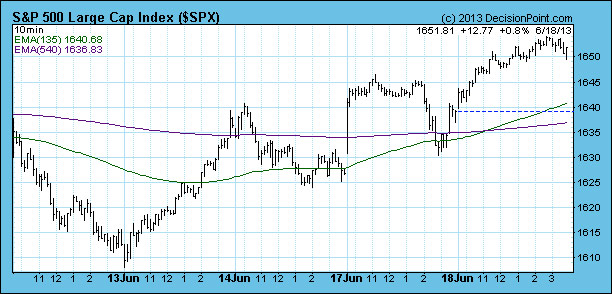
Stocks: Based upon a 12/10/2012 Thrust/Trend Model buy signal, our current intermediate-term market posture for the S&P 500 is bullish. The LT Trend Model, which informs our long-term outlook, is on a buysignal as of 12/13/2012, so our long-term posture is bullish.
Price continued to rally after breaking out of the triangle pattern. The PMO turned up today on mediocre volume. In the thumbnail, price broke above the neckline of the bullish double-bottom pattern that we have been watching for the last few days. When a double-bottom pattern executes, the minimum upside target is the length of the pattern from bottom to neckline. In this case, that would put price at the top of the rising trend channel or just above it around 1700.
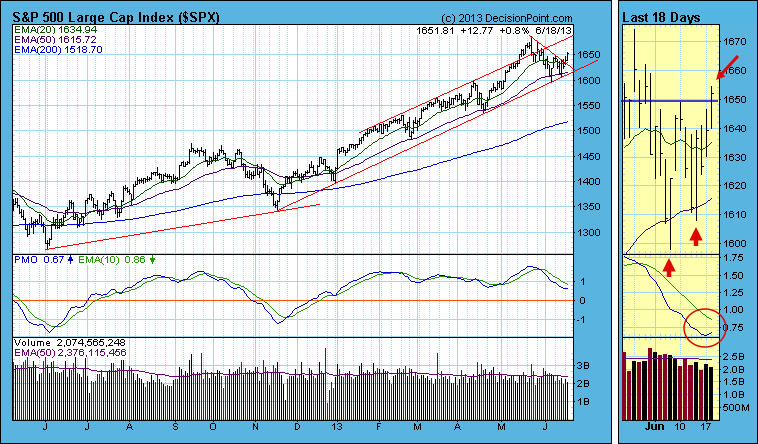
The CVI and Participation Index – UP hit climactic readings today.

Short-term indicators are neutral except for the STVO which just reached somewhat overbought territory.
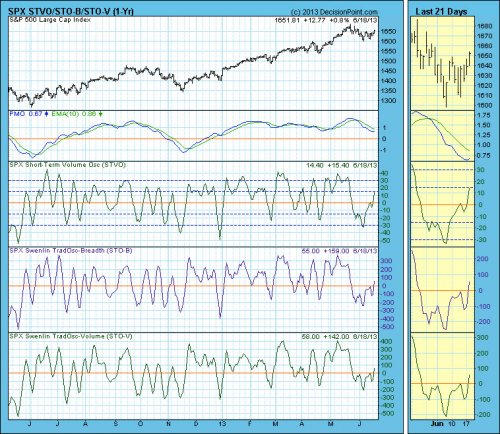
The ITVM turned up today, joining the ITBM which turned up yesterday
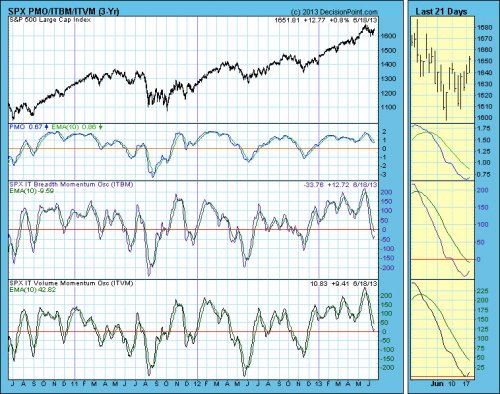
Conclusion: The market is short-term bullish given that ultra-short-term indicators just hit climactic readings as price is starting to come out of a bottom, and there was the execution of the bullish double-bottom pattern. The apple cart could be upset if the Fed announces tapering or ending its bond buying program tomorrow after its meeting.
Gold: As of 12/6/2012 Gold is on a Trend Model neutral signal. The LT Trend Model, which informs our long-term outlook, is on a sell signal as of 2/15/2013, so our long-term posture is bearish.
Gold suffered today. According to Kitco.com, this was primarily due to sellers not a strong dollar. The dollar was only up .1% today, so that makes perfect sense. The PMO turned down which is also bearish.
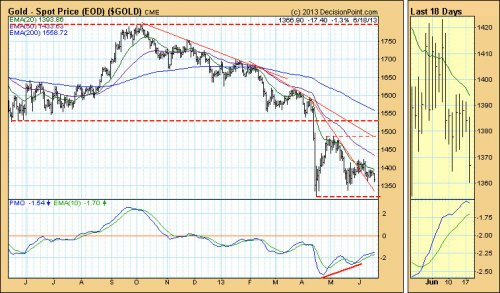
About Erin Swenlin Heim
Erin Swenlin Heim is the daughter of Carl Swenlin, the president and founder of DecisionPoint.com. Erin holds a Bachelor’s degree in Mathematics from the University of Southern California and is a graduate of the Air Force Institute of Technology where she earned a Masters degree in Information Resource Management. Erin began working in Decision Point around 1997, starting with billing and customer service and expanding into processing daily website updates. She is engaged in a continuing apprenticeship to Carl, who is helping her build a solid foundation in the Decision Point method of technical analysis.

Silver: Will it drop to $10/ounce?
Posted by P. ZIHLMANN INVESTMENT • MANAGEMENT AG
on Wednesday, 19 June 2013 14:16
Up-date N° 26 / June 18, 2013
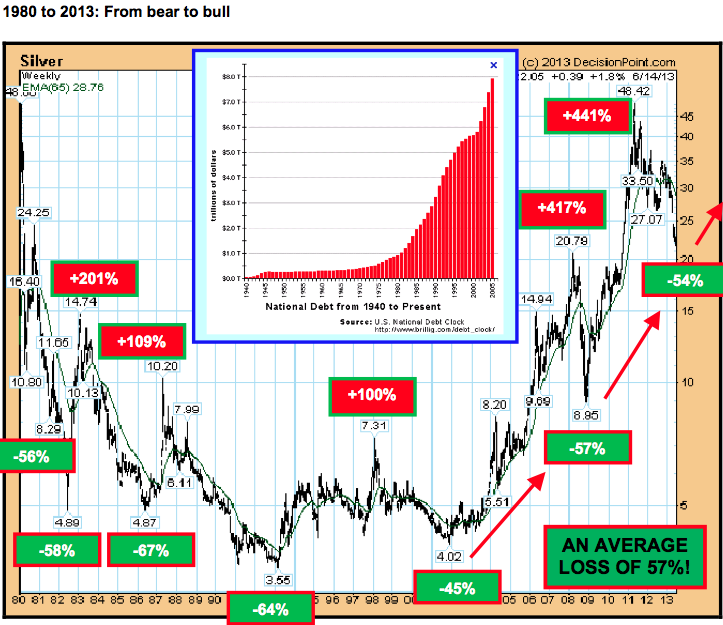


-
I know Mike is a very solid investor and respect his opinions very much. So if he says pay attention to this or that - I will.
~ Dale G.
-
I've started managing my own investments so view Michael's site as a one-stop shop from which to get information and perspectives.
~ Dave E.
-
Michael offers easy reading, honest, common sense information that anyone can use in a practical manner.
~ der_al.
-
A sane voice in a scrambled investment world.
~ Ed R.
Inside Edge Pro Contributors

Greg Weldon

Josef Schachter

Tyler Bollhorn

Ryan Irvine

Paul Beattie

Martin Straith

Patrick Ceresna

Mark Leibovit

James Thorne

Victor Adair

